Il Palio di Siena
Il Palio di Siena is a world famous medieval horse race organized in the city of Siena located in the Italian province of Tuscany. Siena was first settled by the Etruscans (c. 900 BC to 400 BC). It got its name from the Etruscan tribe called the Saina.
The Palio di Siena is held twice a year. The first palio of the year called „Palio di Provenzano“ is held on the 2nd of July. It is both the feast honouring Madonna of Provenzano and the Feast of the Visitation. The Palio is held for the second time, as „Palio dell'Assunta“, on the 16th of August, the day after the Feast of the Assumption. The same as the one in July it is dedicated to the Virgin Mary.
Let's just mention that the palio generally describes different festival of medieval origin. Such festivals often include competitions like horse racing, archery, jousting, crossbow shooting etc. There are many such competitions in Italy and some other countries but the palio in Siena is one of the most famous.
The Palio di Siena is a competition of 17 contrade of Siena. They are administrative city districts formed in the middle ages. Their main purpose was to provide enough funds and soldiers for the army that defended Siena from attacks by neighbouring medieval states.
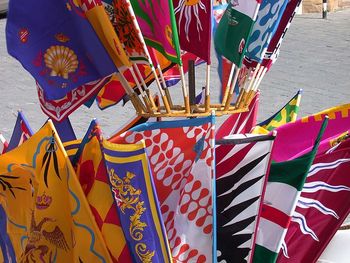 Banners of 17 contrade participating in Palio di Siena
Banners of 17 contrade participating in Palio di Siena
 Aquila
Aquila
Aquila (Eagle), from the area immediately to the southwest of the Piazza del Campo in the centre of the city, is considered one of four noble contrade. It got its title by the Habsburg Emperor Charles V in return for the warm welcome during his visit in 1536. Siena's the duomo (cathedral) is located in this contrada. The Virgin Mary is the patron of this contrade. The contrada was famous for its notaries. Aquila's symbol is a double-headed black eagle holding an orb, a sword and a sceptre. Its colours are yellow, trimmed with blue and black. The oldest Palio di Sienna banner, from 1719, is part of a local museum. Aquila is an ally with two contrade - the Civetta (Owl) and Drago (Dragon). Auquila's enemy on the other side is the Pantera (Panther) contrada.
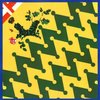 Bruco
Bruco
Bruco (Caterpillar), from the part of city north of the Piazza del Campo, is the second of noble contrade, but is generally working class neighbourhood. People there used to be in the silk business. It got its title of nobility because of its bravery in defeating Charles IV of Bohemia. Its patron is Madonna. She is honoured on the the 2nd of July. Bruco's symbol is a crowned caterpillar crawling on a rose. Its colours are green and yellow, trimmed with blue. It is the ally of three contrade - Istrice, Nicchio and Torre. The Caterpillar contrada is the one with no enemy.
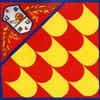 Chiocciola
Chiocciola
Chiocciola (Snail), from the southwest of Siena, is a contrada of a very old name. It got it sometime in 1200. The local baptismal fountain in front of the San Paolo church is rather special. In case of a victory in the Palio it pours out wine. Its residents used to be terracotta makers.
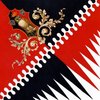 Civetta
Civetta
Civetta (Owl), from the area just north of Piazza del Campo, has the title priora. It is the contrade of shoemakers. The symbol of this contrada is a crowned owl sitting on a branch. Its colours are red and black striped with white. Among the fans this contrada is known as „nonna“ as it has not won the Palio for more than 30 years.
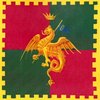 Drago
Drago
Drago (Dragon), located northwest of Piazza del Campo, was famous for its bankers. Drago's symbol is a flying golden dragon carrying a banner with the letter "u". Its colours are red and green, trimmed with yellow. It includes a street called Palla a Corda with a dead end. During the Palio this street is turned into a shopping mall.
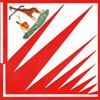 Giraffa
Giraffa
Giraffa (Giraffe), located northeast of Piazza del Campo, is one of only two so called imperial contrade. It won the palio in 1936 and the prize was presented by the Italian King Vittorio Emanuele. This is part of Siena used to be famous for its painters. The symbol of contrada is a giraffe led by a Moor, and a ribbon bearing the motto "Humbertus I dedit" (Umberto I gave it"). Its colours are white and red.
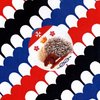 Istrice
Istrice
Istrice (Porcupine), located in far northwest part of Siena, is the second of imperial contrade. It is very old. It was formed in the Etruscan times. It got its imperial title as the headquarters of The Sovereign Military Order of Malta was located here. Istrice's symbol is a porcupine. Its colours are red, white, blue and black.
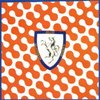 Leocorno
Leocorno
Leocorno (Unicorn), from the area west of Piazza del Campo, has a special treasure in its museum. It is a bell that has been taken from the war chariot belonging to the city of Florence. Many goldsmiths used to reside in this contrada. Leocorno's symbol is a unicorn, rampant, with the motto "Humberti regio gratia" ("A kingdom by the grace of Umberto"). Its colours are orange and white, bordered with blue.
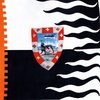 Lupa
Lupa
Lupa (She-Wolf), located north of the Piazza del Campo, was traditionally populated by bakers. The symbol of this contrade is a she-wolf nursing twins. Its colours are black and white, trimmed with orange. As to the legend, Siena was founded by Senius, the son of Remus who, the same as his twin brother Romulus, was raised by a wolf.
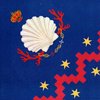 Nicchio
Nicchio
Nicchio (Shell), from the far eastern part of the city, is the noble contrada. It got the title because of bravery shown during the Battle of Montaperti against Florence in 1260. Local soldiers led the attack. Many of local people used to be potters. The symbol of the contrade is a crowned scallop shell flanked by two branches of coral. Its traditional colours are blue, with yellow and red trim.
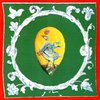 Oca
Oca
Oca (Goose), from the area west of the Piazza del Campo, is the fourth of noble contrade. It got the title as local people were very brave in wars led by Siena. Its residents used to make dyes. Oca's symbol is a crowned goose wearing around its neck a blue ribbon marked with the cross of Savoy. Its colours are green and white, with red trim. Only this ontrada has no allies.
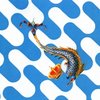 Onda
Onda
Onda (Wave), from the area south of the Piazza del Campo, has the title of contrada capitana (captain contrada) as in the past its soldiers were guards at the Palazzo Pubblico. Onda's symbol is a dolphin. Its colours are white and sky blue and the condrada describes itself as "The colour of Heaven, the force of the sea". Onda is the ontrade of carpenters.
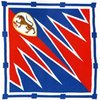 Pantera
Pantera
Pantera (Panther), from the west of Siena, has the symbol of a rampant panther. Its colours are red, blue and white. In the past local people were grocers and chemists.
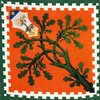 Selva
Selva
Selva (Forest), from the area west of Piazza del Campo, is the contrada whose residents were weavers but when needed, during wars, also excellent archers. Selva's symbol is a rhinoceros at the base of an oak tree hung with hunting tools. Its colours are green and orange, bordered with white.
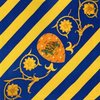 Tartuca
Tartuca
Tartuca (Tortoise), from the south of Siena, used to be part of the city with many sculptors. The symbol is a turtle with alternating Savoy knots and daisies. Its colours are yellow and deep blue. People of this contrada are enemies of the Chiocciola (Snail) contrada.
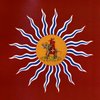 Torre
Torre
Torre (Tower), from the area southeast of Piazza del Campo, used to have many woolcombers. This contrada also includes the Siena's Jewish quarter and a synagogue. Torre's symbol is an elephant (the contrada's original name was Liofante or Lionfante) with a tower on its back. Its colours are crimson, striped with white and blue. This contrada is not in best relations with two contrade – The Oca and The Onda.
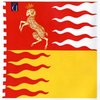 Valdimontone
Valdimontone
Valdimontone (Ram), located the southeast of the city near Porta Romana, is a contrada of tailors. The symbol of this contrada is a crowned rampant ram, with a blue shield including the letter "u" standing for Umberto. Its colours are red and yellow, with white trim. Its ally is the Onda. Valdimontone is the enemy of the Nicchio contrade.
After all these details about the contrade participating in the Palio di Siena, let’s move to the race itself. For the race to be organized well there are many things to be done. There are discussions, fund raising meetings, rehearsals held in the presence of elected leaders and representatives of the contrada. If needed costumes for the event are renewed or remaked.
During the Palio, everyone in the audience will wave a multicoloured handkerchief. The handkerchiefs, in colours of their contrade, are also worn by horses dashing along the Piazza del Campo.
The piazza was a place of different competition for centuries. Competitions called „pugna“ which included boxing, jousting and bull fights were popular in the 14th century. In 1590 bull fights were banned. Races started to be organized. First of these races were so called „bufalate“ or races on buffalo-back and „asinate“ or races on donkey-back. Races on horses were then organized in other parts of the city. The first modern Palio (called Palio alla Tonda) was held around 1650.
The race includes 10 horses meaning not all the contrade can participate. Seven contrade who do not compete in the first race run in the second one. Three more places in the second race are randomly chosen. Six trials are held before every race.
Parade called the Corteo Storico with people wearing magnificent medieval costumes is held before the race. Especially fascinating participants of the parade are „alfieri“ or flag wavers.
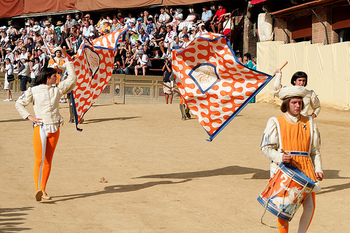 Alfieri or flag wavers
Alfieri or flag wavers
The race starts at 7.30 pm. The race has three laps. The racing track is covered with some dirt or "tufa". Nine horses, with jockeys riding bareback, enter the starting area (between two ropes). The tenth horse or „rincorsa“ stands outside. When this horse enters the starting area the starter or „mosiere“ activates the mechanism which removes the front rope and the race begins. This whole ritual before the race is called the Mossa. The riders can use whips (made of dried bull's penises) or „nerbi“.
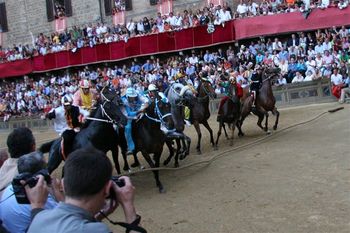 Riders at the starting line
Riders at the starting line
The winner is the horse that crosses the finishing line with its head ornament in its place. It does not matter if the winning horse has a rider on him when finishing the race.
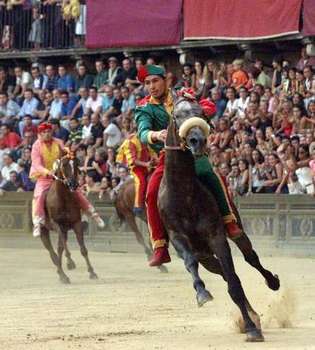 The race consisting of 3 laps
The race consisting of 3 laps
The winner gets a beautiful silk banner called Palio. The flag is made especially for the particular year. Everyone in the winning contrada celebrates the victory.